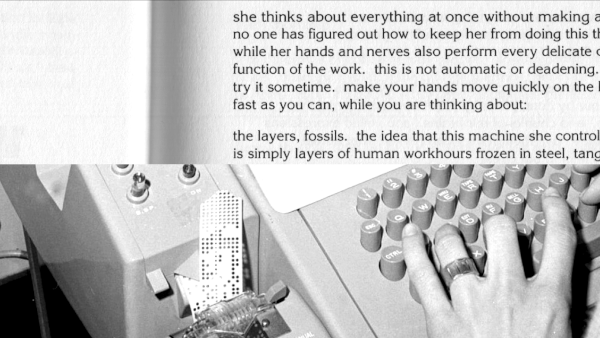TTY: Difference between revisions
No edit summary |
No edit summary |
||
| Line 1: | Line 1: | ||
[[File:Holes-hands.png|600px|frame|right|From Karen Brodine, ''Woman Sitting at the Machine, Thinking'' (https://davidbuuck.com/downloads/tripwire_4_brodine.pdf)]] | [[File:Holes-hands.png|600px|frame|right|From Karen Brodine, ''Woman Sitting at the Machine, Thinking'' (https://davidbuuck.com/downloads/tripwire_4_brodine.pdf)]] | ||
=== Introduction === | |||
This issue will start from a single technical object: a teletype machine. The teletype is the meeting point between typewriters and computer interfaces, a first automated translator of letters into bits. Equipped with a keyboard, a transmitter and a punchcard read-writer, it is a historical link between early transmission technology such as the telegraph and the internet of today. | This issue will start from a single technical object: a teletype machine. The teletype is the meeting point between typewriters and computer interfaces, a first automated translator of letters into bits. Equipped with a keyboard, a transmitter and a punchcard read-writer, it is a historical link between early transmission technology such as the telegraph and the internet of today. | ||
The teletype ushered in a new mode of inscription of writing: if the typewriter set up a grid of letters and voids of the same size, turning the absence of a letter (the space) into a key itself (the spacebar), the teletype finished it by inscribing the space in the very same material as all other letters: electrical zeros and ones, that were to immediately leave the machine. | The teletype ushered in a new mode of inscription of writing: if the typewriter set up a grid of letters and voids of the same size, turning the absence of a letter (the space) into a key itself (the spacebar), the teletype finished it by inscribing the space in the very same material as all other letters: electrical zeros and ones, that were to immediately leave the machine. | ||
| Line 7: | Line 7: | ||
This makes this interface from 50 years ago highly interoperable with present ones, which gives us the possibily for a very hands-on approach for developing our theory of this medium, creating short-circuits that allow us to re-think technical progress and computational genealogies. | This makes this interface from 50 years ago highly interoperable with present ones, which gives us the possibily for a very hands-on approach for developing our theory of this medium, creating short-circuits that allow us to re-think technical progress and computational genealogies. | ||
One such machine will be hosted and available for use and experimentation for the trimester. | One such machine will be hosted and available for use and experimentation for the trimester. | ||
=== Format === | |||
Each week we will host a guest contributor who will join us in unfolding the multiple cultural and technical layers that we found stratified in such a machine, reading them as questions to our contemporary involvements with computing and networks. | |||
== Schedule == | == Schedule == | ||
Revision as of 12:28, 3 April 2023

Introduction
This issue will start from a single technical object: a teletype machine. The teletype is the meeting point between typewriters and computer interfaces, a first automated translator of letters into bits. Equipped with a keyboard, a transmitter and a punchcard read-writer, it is a historical link between early transmission technology such as the telegraph and the internet of today. The teletype ushered in a new mode of inscription of writing: if the typewriter set up a grid of letters and voids of the same size, turning the absence of a letter (the space) into a key itself (the spacebar), the teletype finished it by inscribing the space in the very same material as all other letters: electrical zeros and ones, that were to immediately leave the machine. The Teletype Model 33, one of the most widely produced and distributed text-based terminals in the 1970s, introduced multiple technological concretizations that are present in the computers of today as a sort of legacy, such as the QWERTY Keyboard with control keys, the ASCII character encoding and the TTY terminal capability. This makes this interface from 50 years ago highly interoperable with present ones, which gives us the possibily for a very hands-on approach for developing our theory of this medium, creating short-circuits that allow us to re-think technical progress and computational genealogies. One such machine will be hosted and available for use and experimentation for the trimester.
Format
Each week we will host a guest contributor who will join us in unfolding the multiple cultural and technical layers that we found stratified in such a machine, reading them as questions to our contemporary involvements with computing and networks.
Schedule
Tuesday April 11th
With: Martino, Michael, Manetta, Joseph, Steve
Monday April 17th
With: Andrea di Segero Alighieri, Martino
Monday April 24th
With: Roel Roscam Abbing, Martino
Monday May 1th
Off
Monday May 8th
With: Elodie Mugrefya, Martino
Monday May 15th
With: Femke Snelting, Martino
Monday May 22nd
With: Isabelle Sully, Martino
Monday May 29th
With: Zoumana Meïté, Martino
Monday June 5th
Off
Monday June 12th
With: Jara Rocha, Martino
Monday June 19th
Monday June 26th
Thursday June 29th
Grad show..
